
|
|||
| THE ONLINE FIRE NEWS SOURCE | |||
FIREFIGHTERS TRY TO KEEP BISCUIT FIRE INSIDE LAWSON CREEK WATERSHEDAUGUST 14 -- GRANTS PASS, OR: Firefighters are gaining ground along the south and east flanks of the Biscuit Fire and are mopping up and burning out strategic locations to prevent further spread. But they're having trouble along the north and west flanks, particularly in the Lawson Creek area south of Agness. The fire's been spotting across firelines there. Crews are preparing the western ridge of Lawson Creek today in hopes of containing the fire within the watershed boundary. The 390,276-acre fire is burning outside containment lines below Snow Camp Mountain; crews finished a segment of critical fireline there yesterday.
The entire complex is estimated at 26 percent containment. Burnout operations were successful yesterday along the southwest flank of the fire between the Chetco River and Long Ridge; all indirect line along the northern perimeter of the fire has been prepared for burnout operations. Firefighters are waiting for fire behavior and weather conditions to improve before they begin. Smoky conditions yesterday grounded helicopters along the entire west flank, and locations for new helispots are being identified. The Biscuit Fire — one of the largest in Oregon's history — encompasses most of the Kalmiopsis Wilderness and stretches from 10 miles east of Brookings south into California, east to the Illinois Valley, and north to within a few miles of the Rogue River. The fire is the top priority for the Pacific Northwest Region with 6,410 personnel including members of the Oregon National Guard and firefighters from Canada, Australia, and New Zealand. The Biscuit Fire's joint information center is online at www.biscuitfire.com and includes current maps, fire updates, and a photo gallery.
SATELLITE SHOT FROM 08/13/02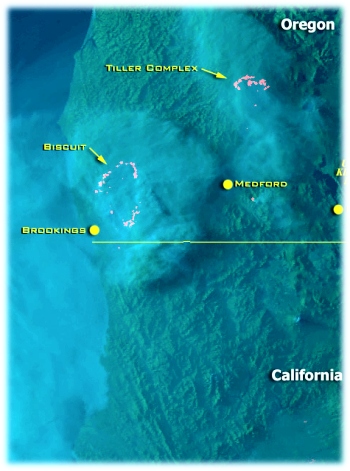
CHERRY CREEK FIRE NEARLY CONTAINEDAUGUST 14 -- GOLDEN, CO: Firefighters pounded the Cherry Creek Fire yesterday, containing 90 percent of the 1,400-acre blaze despite adverse weather conditions. The Durango Herald reported that full containment is expected by tonight. Retardant and water drops by airtankers and helicopters, and hard work by local fire crews and bulldozers were the two primary factors in beating the blaze, said Ron Klatt, the incident commander. Crews took advantage of plowed fields in the area to stop the fire’s spread. The blaze remained at about 1,400 acres; county officials said the fire was 1,500 acres Monday night, but estimates were revised early Tuesday. The cause of the fire was determined to be lightning that occurred last week. Lightning starts can smolder under the ground or in surface fuels before conditions trigger an ignition days later. About 25 residences and 25 outbuildings were still threatened Tuesday, but only a recreation-style trailer has been lost. The fire’s cost is estimated at $332,000.
BISCUIT FIRE BURNS SNOWCAMP LOOKOUTAUGUST 14 -- BROOKINGS, OR: The historic Snow Camp Mountain lookout burned on Monday, according to the Curry Coastal Pilot.
The lookout, 36 miles northeast of Brookings, was built in 1958. It was a 15-foot by 15-foot cabin-type structure at ground level, located atop Snow Camp Mountain. Since 1990, it has been available to the public for overnight stays. Firefighters were also working Tuesday near the Quail Prairie Mountain lookout, which has so far survived the fire. The fire was moving west along the Chetco River near Tolman Ranch, and crews were removing brush from roadsides. Firefighters were pulled from firelines and sent to safety zones near the break between Zone 1 (east) and Zone 4 (west) when the fire there spotted over firelines.
COLORADO FIRES FORCE EVACUATIONSAUGUST 14 -- GOLDEN, CO: Two wildfires are burning near Golden this morning, one dangerously close to the Blue Mountain Estates subdivision, according to a report by the Denver Post. Some residents in the evacuation area stayed behind to protect their homes. The fires are within a quarter-mile of each other near Highway 93 at the mouth of Coal Creek Canyon, about 30 miles northwest of Denver. Highway 72 is closed at Highway 93. The Jefferson County Sheriff's Office said at least 60 acres have burned, and 9news.com reported that 90 homes were evacuated. Officials believe a spark from a train may have started the fires sometime after 5 a.m.
OREGON TIMBER HARVEST REACHES NEW LOWAUGUST 14 -- SALEM, OR: The volume of Oregon timber cut in 2001 marks a new low in 12 years of dwindling harvests since the spotted owl was listed under the Endangered Species Act, according to a report in the Statesman-Journal. Last year's harvest was 3.44 billion board feet, down more than 400 million board feet from 2000, according to the Oregon Department of Forestry’s newly released annual harvest report. Federal lands in Oregon recorded the lowest harvest since 1942. The Medford Mail-Tribune also reported that people at a community forum on Tuesday agreed that Oregon forests desperately need thinning to reduce the threat of severe wildfires. The forum included representatives of the timber industry and environmental groups, along with local government officials; the session was led by U.S. Sen. Gordon Smith of Oregon. Many concurred that thinning younger trees and ladder fuels while leaving larger trees is the solution. But others said the first thing that needed to be thinned is lawsuits brought by environmental groups to halt forest management projects. "It would not be wise to go in and clean out the mature trees; the problem is in the young ones," said Lou Gold, a former college professor and longtime environmental activist. The severe fire season is the result of decades of fire suppression, according to Steve Fitzgerald, a silviculturist and associate professor at the Oregon State University Extension Service. An estimated 35 percent of Oregon's forests are at high risk for severe wildfires. "The type of thinning and selective harvesting I'm proposing will need to be different than what was done in the past," he said. Such management could result in less dangerous and less damaging — and less costly — wildfires. "To do this vital work, we need sustained funding of the National Fire Plan to reinvest in our forests to first stabilize their health and then to improve their resiliency to wildfires in the long term," he said. Some people get the connection between the record low harvest and the huge wildfires raging across Oregon. "Certainly we have seen a huge buildup of fuels on the federal forests as a result of steadily declining harvests," said ODF's Rod Nichols. "It's ironic that we're having these huge forest fires, and a lot of it is resistance to allowing the forest to be managed properly." Environmental activists, of course, disagree. "That correlation just doesn't work," said Tim Lillebo with the Oregon Natural Resources Council. "It’s just trying to find a scapegoat for our past logging practices." Nichols said said efforts by the U.S. Forest Service to reduce fuels in forests often are hamstrung by appeals or litigation by environmentalists. "The Forest Service needs to be allowed to manage the forests," he said. 
CALIFORNIA SENATE PASSES BILL TO DELAY VOLUNTEER FIRE PROGRAM REQUIREMENTSAUGUST 13 -- RED BLUFF, CA: California Senators have approved AB 2118, an urgent bill that will save volunteer fire programs in rural California until 2005. The bill, according to the Red Bluff Daily News, would postpone the implementation of SB 1207; it attempts to relieve volunteer firefighters of requirements imposed by SB 1207, which imposes what some say are "grievous time constraints for compliance." SB 1207 requires volunteer firefighters to submit to full medical evaluations, additional training requirements, and "fit testing" with breathing apparatus equipment. "Volunteer firefighters are rural California's first line of defense," said Assemblyman Dick Dickerson of Redding. "It is imperative that they be given adequate time to come into compliance with California law." Volunteer firefighters across the state have commended Dickerson for his action regarding SB 1207, but some call it a much-needed temporary fix of a larger looming problem. The bill is now headed back to the Assembly for a concurrence vote on Thursday. CDF FIREFIGHTERS RECOVERING IN HOSPITALAUGUST 13 -- LOMA LINDA, CA: Three firefighters remain hospitalized after their engine crashed on I-15 on Sunday. The Inland Valley Daily Bulletin reported that the engine's driver, Tim Valadez, 34, is in critical condition after extreme blood loss, a pelvic fracture, and a broken right femur. Dr. Samuel Cemaj, general trauma surgeon at Loma Linda University Medical Center, said Valadez is breathing with the aid of medical devices. Firefighters Wesley Gissell, 26, and Justin Andrews, 19, are also hospitalized. "They said, 'I'm sorry for the engine being wrecked,'" said Fred McVay, Tuolumne/Calaveras Unit Chief. "I told them not to worry, just get well." Valadez was scheduled for surgery on his leg last night, according to a report by the Modesto Bee. Gissell, with a collarbone fracture and scalp cut, and possible spinal injuries, was in stable condition. Andrews also was stable with a collarbone fracture and a spinal fracture. "Thank God they are doing well," said Dan Wurl, assistant chief of the San Bernardino County Fire Department, who was among the first responders. "It was a horrific accident." The best news since the wreck, Wurl said, was that Valadez was alert and oriented Monday afternoon. "One of our chaplains just talked to him. He said he was writing things down and responding, able to communicate. That's a great sign." DURANGO WILDFIRE BURNS 2,000 ACRESAUGUST 13 -- DURANGO, CO: A fire that flared up yesterday about noon had grown to 1,500 acres by nightfall, according to a story in the Denver Post. The fire was estimated at 2,000 acres last night by the Rocky Mountain Area Coordination Center and is about 10 percent contained. Near the community of Redmesa, about 20 miles southwest of Durango, the fire is threatening about 25 homes and has forced the evacuation of about a dozen farms and ranch houses at the south end of Cherry Creek Canyon. The Cherry Creek Fire started near the La Plata-Montezuma county line, according to the Durango Herald, and raced quickly through piñon-juniper in 90º heat. Pushed by winds, the fire tore through Cherry Creek Canyon, growing from about 20 acres to more than 250 acres in 30 minutes, according to Butch Knowlton, director of emergency preparedness for La Plata County. In about four hours, the fire had grown to 1,000 acres. A Type 3 team was handling the fire, with 130 firefighters on the fire, along with 20 engines, four airtankers, two helicopters, seven water trucks, and six bulldozers. Hartman's Type 2 team has been ordered. FIRE TEAM IN THE WAR ROOM DIRECTING OVER 6,100 TROOPSAUGUST 13 -- MEDFORD, OR: With an army of more than 6,100 firefighters from four countries, four incident management zones established, and the largest Oregon wildfire in more than a century on their hands, the area command team set up at Medford has plenty to do. Area Command Team No. 4, one of only four such teams in the nation, includes fire managers from across the country, according to a story in the Medford Mail-Tribune. "What we're doing here is working with the incident management teams on strategic, long-term objectives," explained Ron Coats, assistant area commander for logistics. "Our main goal is to help incident commanders," added Bill Waterbury, assistant area commander for planning. Waterbury, formerly stationed on the Malheur National Forest in Oregon, is assistant director for fire operations in the Southwest Region based in Albuquerque, New Mexico. Coats, based in Atlanta, Georgie, is the fire director for the Forest Service’s Southern Region. The team's commander is Rex Mann, a veteran firefighter with the agency in Kentucky. Other core members include a third assistant area commander, risk assessment specialists, flight restriction experts working with the Federal Aviation Administration, and an office manager. The assignment in Medford is the team's third this year; they oversaw the Toolbox Complex near Lakeview, Oregon, and the Hayman Fire near Pueblo, Colorado. Both fires exceeded 130,000 acres. RED, ORANGE, YELLOW, OR GREEN?AUGUST 13 -- COLORADO SPRINGS, CO: Hundreds of Colorado Springs residents get online every day to see if their house is red, orange, yellow or green.
"I think we've benefited, if that's the right word, from a very active fire season where awareness is high," said David Blankinship, who designed the website for the Colorado Springs Fire Department. "If there's anything good that's come out of these large fires, it's that people are really attuned." Cathy Prudhomme, FireWise program coordinator for the city, said she gets calls every day from homeowners wanting to know how they can change their rating. When rating each home, firefighters used a 12-point checklist including defensible space items such as roofing and siding materials and the density and location of vegetation. Blankinship plans upgrades that will explain to homeowners why their house got the rating it did. About 50 homeowners who did work to reduce wildfire risk have asked for a reassessment. The website's at csfd.springsgov.com and includes sections for homeowners to find their ratings, improve their hazard rating, and reduce wildfire risk. The interactive map shows ratings by parcel, and the site also includes a wildfire mitigation plan and tips on FireWise landscaping. FIREFIGHTER PILOTS STUCK ON THE GROUNDAUGUST 12 -- FRESNO, CA: If this was a "normal" fire season, pilot Bill Waldman and his P-3A Orion airtanker would be in Montana. Instead, Waldman was in Fresno last week preparing for another attack on the McNally Fire on the Sequoia National Forest. "It's been a bad season for us," said Waldman in a story by Charles McCarthy of the Fresno Bee. Waldman's plane entered Navy service in 1964. In 1990, the Navy released it for fire airtanker conversion. Waldman was the first pilot to qualify for fire work in the fastest airtanker in the business. There were seven P3-A airtankers on the active list in mid-June. California Rep. George Radanovich says that excess military planes to bolster the firefighting fleet are needed now. Radanovich blames "what appears to be bureaucratic red tape" for preventing the transfer of newer planes to help combat fires. "It is essential that we use as many airtankers as we can to provide for the safety and support of our men and women who are fighting these fires on the ground," Radanovich said. The story's online from the Fresno Bee. CALIFORNIA FIREFIGHTERS DISAGREE WITH SENATOR'S PLAN TO PROVIDE YEAR-ROUND AIRTANKERSAUGUST 12 -- LOS ANGELES, CA: California State Sen. Bill Morrow doesn't like it that the California Department of Forestry and Fire Protection pulls its airtankers back to Sacramento for maintenance between December and March. He has written a bill, according to a Los Angeles Times story, that would require CDF to keep two airtankers based in southern California through the winter. But state firefighters say the number of acres burned in the region each winter does not warrant keeping active a crew of 14 people to service, load, and fly the planes. "Our experience is, we're able to put out the fires in the winter with the resources available to us," said Louis Blumberg with CDF. "We think it's not the best use of the state's resources." Fire officials view Morrow's bill as an unnecessary intrusion by the Legislature; they fear a precedent that would have lawmakers jockeying to dedicate some of the state's 23 airtankers, nine helicopters, and 13 tactical planes to their own districts. "These are statewide assets, and they have to move where they're needed," said Jim Wright, the department's deputy director for fire protection. Morrow's bill, SB 2020, passed the Senate Natural Resources Committee on a 6-2 vote last Tuesday and goes next to the Senate Appropriations Committee. SHOULD INTERFACE FIRE RESEARCH CHANGE SUPPRESSION TACTICS?AUGUST 12 -- MISSOULA, MT: Researchers investigating the aftermath of major wildfires now think that most burned houses succumb to errant embers, burning after the main fire has swept through, rather than direct affront from the wildfire itself. Jack Cohen, a research scientist at the USFS Fire Sciences Lab in Missoula, thinks it could change the way wildfires in the interface are fought, according to a story published today by kgw.com. "We get the sense that it all happens at once," said Cohen, "that the whole neighborhood explodes into flame, and that's not necessarily the case." If firefighters can safely wait out a crown fire, they might be able to suppress the subsequent threats to homes in the interface. "You don't need to just throw up your hands and say, 'A crown fire goes through and all the houses go up,'" says Cohen. "This provides an additional opportunity for protection." "We're trying to ask, 'How can firefighters make the best use of this new knowledge we have to protect life and property?'" says Bret Butler, a research engineer with the Forest Service's Fire Behavior Project in Missoula. At the Rodeo-Chediski Fire in Arizona, roughly four of every five burned homes were surrounded by unburned trees or lawns. The fire lab at Missoula is online at www.firelab.org and a major fire features section on the Rodeo-Chediski Fire is available online from www.azcentral.com/news/specials/wildfires/ [Editor's note: if you try to hunt this fire section up through azcentral.com or azrepublic.com you'll likely give up in frustration. Just use this link.]
CDF PARKS ENGINESAUGUST 12 -- SACRAMENTO, CA: California Department of Forestry and Fire Protection (CDF) management has withdrawn 10 fire engines from service and has begun an investigation into the cause of the vehicle accident that injured three CDF firefighters yesterday. Chief Jim Wright ordered the action after initial reports indicated that the engine's drive shaft may have malfunctioned. "This was a brand new engine," said Rich Just, CDF's assistant director. "If it had some kind of mechanical failure, we need to know about it." He said CDF will determine whether adjustments need to be made to other similar engines. The firefighters, all from the Tuolumne-Calaveras Unit of CDF, were injured when their engine careened over a freeway embankment and fell 60 feet to a ravine below. They were responding to a fire near Fontana in San Bernardino County. The accident occurred near the intersection of Highway 138 and Interstate 15 at approximately 6 p.m. yesterday. All three firefighters were removed from the vehicle with the Jaws-Of-Life and flown to Loma Linda Hospital for treatment. CDF also flew the families of the firefighters to the area and assigned a liaison to see to their needs. "Step one, we take care of our firefighters and their families," said Just. "Step two, we find out how this happened and do our best to see that it doesn't happen again." Fire Apparatus Engineer Tim Valadez was in critical condition this morning with extreme blood loss and broken bones. Firefighters Justin Andrews and Wesley Grissel were in stable condition. More information is available from Karen Terrill, public information officer with CDF at (916)653-5123. UPDATE 08/13: Recent reports are online from kfwb.com and the Modesto Bee and AUSSIES DEPLOY TO OREGON FIRELINESAUGUST 12 -- GOLD BEACH, OR: Australia and New Zealand have sent 48 of their most experienced firefighters to the U.S. to help with firefighting efforts.
They've been sent to the Biscuit Fire in southwest Oregon. Some of them will assume division supervisor positions; others will manage helicopter bases. The Biscuit Fire was 376,492 acres this morning and was about 25 percent contained. More than 6,100 people are on the fire. The northeast corner of the fire (Chrome Ridge) is still creeping to the northeast, and infrared flights are finding hot spots in the interior. Though the east edge of the fire has cooled considerably, the fire's still active along the northwest edge and the southeast corner near Whiskey Creek. Crews last night continued line construction and firing operations into the Sugarloaf area. Fireline construction, preparing lines for burnouts, and burning will continue in the northwest corner today in order to secure that flank of the fire to minimize the advance toward Agness.
FLORENCE FIRE NOW THE BISCUIT FIREAUGUST 11 -- GOLD BEACH, OR: The Florence Fire was officially renamed the Biscuit Fire today because of confusion associated with the fire's location.
The fire is now estimated at nearly 334,000 acres and is about 25 percent contained. The original Florence Fire started in the Kalmiopsis Wilderness on July 13, and merged with the Sour Biscuit Fire August 7. This fire is the Northwest's top priority, with over 6,100 firefighters on the fire. The Bear Camp Road from Galice to Agness is closed to all users except fire-related traffic and local residents, and the hiking trail through the Rogue River Wild and Scenic Area is closed because of extreme fire danger. According to a report by the Curry Coastal Pilot, the fire's divided into four administrative zones. Kim Martin, of the Great Basin national Incident Management Team, is in charge of Zone 3 and based near Upper Chetco School. Doug Bright is the Zone 4 IC on the Oregon and California Management Team and is headquartered in Gold Beach. Wally Bennett's Northern Rockies Team, stationed in Crescent City, California, is in charge of Zone 2. Mike Lohrey's Pacific Northwest Team is in charge of Zone 1 from Lake Selmac. The Daily Triplicate in Crescent City reported that gusty winds on Thursday pushed the fire across a fireline and prompted the evacuation of Gasquet residents. A fire weather watch was issued for southwest Oregon for strong northeast winds and low humidity; wind speeds this afternoon at Agness are running 14-18 mph. More than 504,000 acres have burned across public and private lands in Oregon this year. That's 2½ times the 10-year average of 195,000 acres, according to a report in the Eugene Register-Guard. "The increase in fires is quite significant," says Sam Sandberg, head of a Corvallis-based fire and environmental research team for the U.S. Forest Service. "We've had a five-fold to six-fold increase in acres burned in the Northwest over the last decade." SOUTHERN CALIFORNIA BRUSHFIRE EVACUATES 150 RESIDENTSAUGUST 11 -- PALM SPRINGS, CA: A brushfire in Riverside County forced the evacuation of 150 residents and threatened about 100 residents today. The 250-acre fire was reported at 2 p.m. in Riverside County, about 30 miles west of Palm Springs. The fire, near Interstate 10 between Riverside and Palm Springs, was growing fast. More than 250 firefighters were on the fire, according to CDF. According to a report by NBC4-TV the fire was growing fast. The fire is burning in scrub oak and is threatening orchards and horse ranches, and sheriff's deputies were notifying residents of about 150 homes to evacuate. EVACUATED WASHINGTON RESIDENTS BACK HOMEAUGUST 11 -- MURDOCK, WA: firefighters earlier today contained a 400-acre fire burning west of Murdock, according to Associated Press reports, and hundreds of evacuated residents were allowed to return home. The fire was contained by about 1:30 a.m. - six hours after it started, according to Klickitat County Emergency Management. Four houses were destroyed; three firefighters were doing fine at a nearby hospital, where one went for help with soot in his eye. The others suffered minor smoke inhalation. The burned between Washington 14 - the main highway in the area - and the Columbia River. Winds of up to 30 mph Saturday night pushed the fire toward town, and 400 people evacuated Saturday night returned home today. SOUTHERN OREGON SMOKEOUT
The Oregon Department of Transportation road cams show smoky hills in the distance. Satellite shots online from NOAA's Operational Significant Event Imagery team dramatically illustrate the smoke drift from Oregon's biggest fires. The Ashland Daily Tidings reported that the eerie smoky conditions are attributed to the Timbered Rock Fire in addition to the Tiller Complex, and the smoke was expected to linger. Haze hangs heavy over the Illinois Valley, and a lingering inversion has kept a heavy smoke cover hugging the mountains and river canyons. The Anchorage Daily News reported that this summer is one of the smokiest ever in Fairbanks. Friday was the sixth straight day that smoke was thick enough to restrict visibility at Fairbanks International Airport to 6 miles or less. It was the 15th day of smoke in Fairbanks this summer, ranking behind only 1969, when there were 19 days of smoke in town, according to records dating to 1965. "It's going to be awhile before we see the Alaska Range," said meteorologist Rick Thoman. "By the middle of next week there may be enough rain on the fires to make a difference." Smoke is being blown into Fairbanks from forest fires to the west and southwest. This is the first summer since the NWS began keeping records that Fairbanks has experienced limited visibility due to smoke in May, June, July and August.
DEPARTMENT OF DEFENSE CRITICIZED FOR NOT SUPPLYING AIRTANKERSAUGUST 11 -- WASHINGTON, DC: After two fatal airtanker crashes in this record-breaking fire season, lawmakers are criticizing the Defense Department for delays in turning over excess aircraft to battle wildfires. According to an Associated Press report, six years after Congress directed the Pentagon to cull its fleet for aircraft that could be converted to firefighting tankers, the first replacement has yet to arrive. The average age of aircraft in the nation's firefighting fleet is 47 — the oldest was built in 1943, and the newest one, according to the Federal Aviation Administration, is 36 years old. "We badly need to replace some old stuff," said Ed Stone, branch chief of aviation policy for the U.S. Forest Service. The severity of this year's season has resulted in the airtankers' flying more than double their usual number of hours. Through July 24, the tankers had logged 7,658 hours in the air. In most years, they fly about 5,900 hours annually. The AP story is available online from the Billings Gazette. FIRE DEBATE COULD GET HOTAUGUST 11 -- WASHINGTON, DC: As wildfires rage across the West, a political conflagration is brewing over environmental laws that protect or, some say, endanger the national forests and people who live nearby. "A heated debate is expected next month when a group of Western senators hopes to increase federal funding both for firefighting and for treating at-risk forests to avoid more seasons like this one," according to columnist Larry Swisher. Politicians accuse environmentalists of having thwarted and delayed fuels reduction projects, and House members have introduced a bill that would suspend the Endangered Species Act and other laws for such projects. Earlier this month, Sen. Dianne Feinstein of California and Sen. Ron Wyden of Oregon added some bipartisan flavor to an otherwise all-Republican group seeking a new approach to national forest management. According to a story in the Spokane Spokesman-Review, Republicans have said they want to ease the appeals process that environmentalists have used to hold up proposed forest restoration projects on forests across the West. "The environmental folks still would have a place at the table, but they would no longer be able to veto (forest management plans) by tying things up in court," said Lindsay Nothern, spokesman for Sen. Michael Crapo of Idaho. "The obstructionism of some environmental extremists is putting homes, businesses, wildlife habitat, water and air quality all at great risk," says Arizona Gov. Jane Hull. "Communities in and around Flagstaff, Prescott, Mount Graham, and others around the state have been achieving public consensus on thinning projects for years, only to have extremist groups file last-minute appeals halting the process and leaving those communities in peril." The green groups claim senators are planning their own "anti-environmental rider" to the annual appropriations bill for the Forest Service and Department of Interior. Swisher's column is online courtesy of the Eugene Register-Guard, and Gov. Hull's comments are on the Arizona Daily Star website. GROUNDING AIRTANKERS COSTLYJULY 30 -- DENVER, CO: The cost of grounding nine airtankers is averaging about $34,000 per day, according to an Associated Press report, because the Forest Service is obligated under contract to pay daily availability rates on the grounded tankers. Five C-130As and four PB4Y-2s were grounded after two fatal crashes on fires in the last two months. Tony Kern, USFS assistant director for aviation, said the agency is committed to safety. "Until we're able to determine that there's a fixable problem or that the problem does not relate to the rest of the fleet," he said, "the aircraft will not fly for our missions." A nandotimes.com report noted that some problems with the fleet were discovered during routine systems checks or between-flight maintenance. But others weren't, like the two episodes in which pilots and mechanics discovered cracked wings after they saw fuel spilling onto the tarmac. In dozens of other cases, troubles occurred in the air — a situation that often forced airtanker pilots to jettison loads. The realities facing a fleet of planes built in the 1940s, '50s and early '60s have helped fuel a debate about whether the time has come to replace the nation's airtanker fleet with modern aircraft. The sfgate.com story is online, and Kevin Vaughan's report is online courtesy of nandotimes.com FIRE BOSSES IN SHORT SUPPLYJULY 24 -- BOISE, IDAHO: In the middle of July, according to a report by National Public Radio, more than 4,000 fire bosses — helicopter managers, engine and dozer bosses, incident commanders and other overhead — were mobilizing 15,000 firefighters in the Western United States.
This is nothing new. During the fire season of 2000, overhead personnel were imported from Australia and Canada, shoring up the numbers of managers needed to direct the efforts of ground troops fighting fires. During the 1994 season, retired federal fire supervisors were brought back to the firelines to help deal with the numbers and severity of that year's fires. The story's available online from NPR. COLORADO RESIDENT DONATES BIRTHDAY TO FIREFIGHTER FUNDJULY 04 -- COLORADO SPRINGS, CO: The Wildland Firefighter Foundation received a letter today from Mike Lohrey's incident management team explaining the donation made to the Firefighter Fund by a Colorado Springs resident named Chris Rothenbury. He wanted to show his support and empathy for all wildland firefighters, because he'd been listening to and reading stories of firefighters from across the country who traveled great distances to fight the Hayman Fire. On his seventh birthday, instead of receiving the usual mix of cards and gifts, he asked that all his friends and family make donations in memory of all heroic firefighters across the country. The letter from Lohrey's team is online here.
| |||


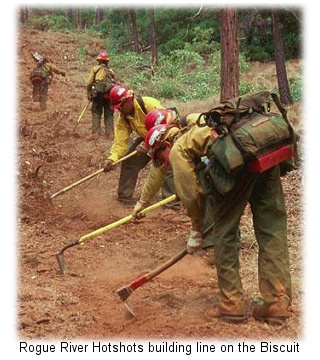 The fire is also burning outside containment lines near Quail Prairie Mountain, but with the help of helicopters yesterday, crews were able to contain some of the fire near Emily Creek.
The fire is also burning outside containment lines near Quail Prairie Mountain, but with the help of helicopters yesterday, crews were able to contain some of the fire near Emily Creek.
 Firefighters tried unsuccessfully to save the lookout by clearing around it and wrapping it in fireproof material.
Firefighters tried unsuccessfully to save the lookout by clearing around it and wrapping it in fireproof material.
 A story in the
A story in the 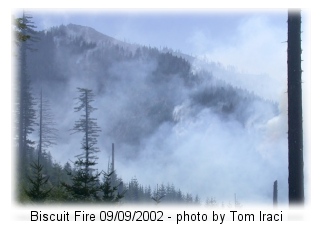 A
A 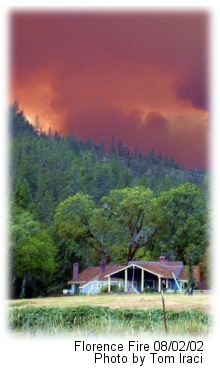 The Florence Fire was named for Florence Creek on the Siskiyou National Forest, but many people thought the fire was near the town of Florence, about 100 miles northwest on Oregon's coast.
The Florence Fire was named for Florence Creek on the Siskiyou National Forest, but many people thought the fire was near the town of Florence, about 100 miles northwest on Oregon's coast.
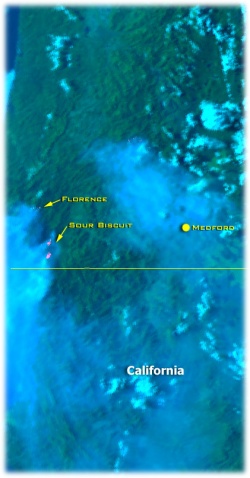
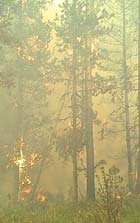 Don Smurthwaite at the National Interagency Fire Center (NIFC) said that for some of the key fire management positions, the agencies have lost 20 percent to 50 percent of qualified personnel between 1995 and 2000.
Don Smurthwaite at the National Interagency Fire Center (NIFC) said that for some of the key fire management positions, the agencies have lost 20 percent to 50 percent of qualified personnel between 1995 and 2000.